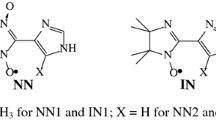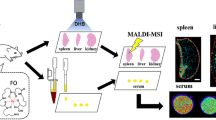Abstract
The recent development of electron paramagnetic resonance (EPR) permits its application for in vivo studies of nitric oxide (NO). In this study, we tried to obtain 3D EPR images of endogenous NO in the abdominal organs of lipopolysuccaride (LPS) treated mice. Male ICR mice, each weighing about 30 g, received 10 mg/kg of LPS intraperitoneally. Six hours later, a spin trapping reagent comprised of iron and an N-dithiocarboxy sarcosine complex (Fe(DTCS)2, Fe 200 mM, DTCS/Fe = 3) were injected subcutaneously. Two hours after this treatment, the mice were fixed in a plastic holder and set in the EPR system, equipped with a loop-gap resonator and a 1 GHz microwave. NO was detected as an NO-Fe(DTCS)2 complex, which had a characteristic 3-line EPR spectrum. NO-Fe(DTCS)2 complexes in organ homogenates were also measured using a conventional X-band EPR system. NO-Fe(DTCS)2 spectra were obtained in the upper abdominal area of LPS treated mice at 8 h after the LPS injection. 3D EPR tiled and stereoscopic images of the NO distribution in the hepatic and renal areas were obtained at the same time. The NO-Fe(DTCS)2 distribution in abdominal organs was confirmed in each organ homogenate using conventional X-band EPR. This is the first known EPR image of NO in live mice kidneys.
Similar content being viewed by others
References
Ignarro LJ: Biosynthesis and metabolism of endothelium-derived nitric oxide. Annu Rev Pharmacol Toxicol 30: 535-560, 1990
Kuppusamy P, Ohnishi ST, Numagami Y, Ohnishi T, Zweier JL: Three-dimensional imaging of nitric oxide production in the rat brain subjected to ischemia-hypoxia. J Cereb Blood Flow Metab 15: 899-903, 1995
Yoshimura T, Yokoyama H, Fujii S, Takayama F, Oikawa K, Kamada H: In vivo EPR detection and imaging of endogenous nitric oxide in lipopolysaccharide-treated mice. Nat Biotechnol 14: 992-994, 1996
Fujii S, Suzuki Y, Yoshimura T, Kamada H: In vivo three-dimensional EPR imaging of nitric oxide production from isosorbide dinitrate in mice. Am J Physiol 274: G857-862, 1998
Yokoyama H, Fujii S, Yoshimura T, Ohya NH, Kamada H: In vivo ESR-CT imaging of the liver in mice receiving subcutaneous injection of nitric oxide-bound iron complex. Magn Reson Imaging 15: 249-253, 1997
Jackson SK, Madhani M, Thomas M, Timmins GS, James PE: Applications of in vivo electron paramagnetic resonance (EPR) spectroscopy: Measurements of pO(2) and NO in endotoxin shock. Toxicol Lett 120: 253-257, 2001
Pou S, Tsai P, Porasuphatana S, Halpern HJ, Chandramouli GV, Barth ED, Rosen GM: Spin trapping of nitric oxide by ferro-chelates: Kinetic and in vivo pharmacokinetic studies. Biochim Biophys Acta 1427: 216-226, 1999
Fujii H, Koscielniak J, Berliner LJ: Determination and characterization of nitric oxide generation in mice by in vivo L-band EPR spectroscopy. Magn Reson Med 38: 565-568, 1997
Morrissey JJ, McCracken R, Kaneto H, Vehaskari M, Montani D, Klahr S: Location of an inducible nitric oxide synthase mRNA in the normal kidney. Kidney Int 45: 998-1005, 1994
Ahn KY, Mohaupt MG, Madsen KM, Kone BC: In situ hybridization localization of mRNA encoding inducible nitric oxide synthase in rat kidney. Am J Physiol 267: F748-F757, 1994
Millar CG, Thiemermann C: Intrarenal haemodynamics and renal dysfunction in endotoxaemia: Effects of nitric oxide synthase inhibition. Br J Pharmacol 121: 1824-1830, 1997
Fujii S, Yoshimura T, Kamada H: Nitric oxide trapping efficiencies of water-soluble iron(III) complexes with dithiocarbamate derivatives. Chem Lett 9: 785-786, 1996
Author information
Authors and Affiliations
Rights and permissions
About this article
Cite this article
Hirayama, A., Nagase, S., Ueda, A. et al. Electron paramagnetic resonance imaging of nitric oxide organ distribution in lipopolysuccaride treated mice. Mol Cell Biochem 244, 63–67 (2003). https://doi.org/10.1023/A:1022420017570
Issue Date:
DOI: https://doi.org/10.1023/A:1022420017570




